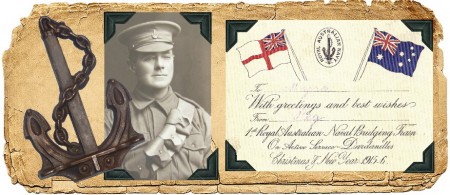The 1st Royal Australian Naval Bridging Train
August 11, 2015
The 1st RANBT, arriving on the Gallipoli Peninsula in August 1915, set up its camp at what became known as Kangaroo Beach. It was responsible for a wide variety of tasks including: building and maintaining wharves and piers, unloading stores from lighters, controlling the supply of fresh water to front line troops, stock-piling engineering equipment, building a light railway for stores movements and carrying out repairs in an open-air workshop.
 Engineering materials were scarce on the Gallipoli Peninsula, and faced with a lack of suitable bolts and iron dowels essential for pier construction, the men turned to a wrecked sand dredge to acquire the necessary material. It’s artificers removed guard-rails and rungs cut from steel ladders to fashion their own fasteners using a portable forge.
Engineering materials were scarce on the Gallipoli Peninsula, and faced with a lack of suitable bolts and iron dowels essential for pier construction, the men turned to a wrecked sand dredge to acquire the necessary material. It’s artificers removed guard-rails and rungs cut from steel ladders to fashion their own fasteners using a portable forge.
From time-to-time men of the 1st RANBT involved themselves in other affairs as revealed by the following account told by a sergeant of the British 32nd Field Ambulance, stationed at Suvla Bay:
Fairly late in the day, as we all lay sprawling on the rocks, I saw a small party staggering down the defile leading to this point. There were two men with cowboy hats and between them they helped another thin and very exhausted looking fellow, who tottered along holding one arm which had been wounded. As they came nearer I recognised my little lance-jack [lance corporal], very pale and a little thinner than usual. The other two were sturdy enough, one short and the other tall, with great rough brown hands, sunburnt faces and bare arms. They wore brown leggings, riding breeches and khaki shirts. They carried their rifles at the trail and strode up to us with the easy gait of those accustomed to outdoor life. ‘Australians’ said someone. “Where’s your boss” asked the tall colonial. “The adjutant is over here” I answered. “We’d like a word with him” said the man. I took them up to the officer and they both saluted in an easy going sort of way. “We found him up there” – the Australian jerked his head – “being sniped at and could not get away; he says he belongs to the 32 Ambulance, so here he is”.
The two were about to slope off again when the Adjutant called them back. “Where did you find him?” he asked. “Up behind Jefferson’s Post; there were five snipers potting at him and it looked mighty like his number was up. We killed four of the snipers and got him out”. “That was very good of you. Did you see any more? We lost some others and an officer and a sergeant.” “No, I did not spot any, did you Bill?” The tall man turned to his mate leaning on his rifle. “No” answered the short sharp-shooter, “He’s the only one. It was a good afternoon sport, very good. We saw he’d got no rifle and was in a tight close-hitch, so we took the job on there and then, finished four of them, but it took some creeping and crawling.” “Well, we will be quitting this now” said the tall one. “There is only one thing we would ask of you sir, don’t let our people know anything about this”. “But, why?” asked the astounded Adjutant, “you saved his life and it ought to be known”. “Yes that may be so sir, but we are not supposed to be up here sharp shooting – we just done it for a bit of sport. Rightly we don’t carry a rifle; we belong to the bridge building section. We only borrowed these rifles from the Cycle Corps and we will be charged with being out of bounds without leave and all that sort of thing if this becomes known.” “All right, I will tell no one, but all the same it was good work and we thank you for getting him back to us,” the Adjutant smiled.
The two Australians gave him a friendly nod and said “so long chaps”, and strode away along the defile.
An excerpt from The 1st Royal Australian Naval Bridging Train, by John Perryman & Commander Greg Swinden, RAN





